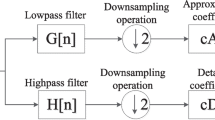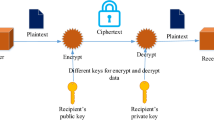Abstract
GIF animations are silent image sequences widely used on the web thanks to their wide support and portability. In this work, we propose an original technique based on data hiding, to add sound tracks in GIF animations. Data hiding is usually used to embed security codes in a host medium to prevent from illegal copying or to protect copyrights (watermarking) or to send secret messages to a dedicated receiver (steganography). We propose to use host GIF images as a “transmission channel” to convey “hidden” sound bits with lowest perceptual image distortion and without altering the wide portability of the GIF format, by means of data hiding. The inserted bits are neither secret nor intended for security issues. They are intended to be played by an audio player synchronously with the GIF player to add sound to the GIF animation. The embedding process is a low complexity, luminance based steganography algorithm, that slightly modifies the pixels colors of the GIF images to insert the sound bits. The extraction of the inserted audio is completely blind: the audio is directly extracted from the pixels of each cover image. The proposed GIF voicing was tested with different GIF sequences (cartoons and real scenes) and no audio degradation was reported while a slight, most imperceptible, color modification was noticed in case of an important amount of inserted data. The cover images have undergone objective quality criteria and informal subjective evaluation and has proved to be of good quality.











Similar content being viewed by others
Notes
LZW: Lempel-Ziv-Welch, lossless data compression algorithm.
PSNR: Peak Signal to Noise Ratio
CD: Compact Disc
kbps: kilo bit per second.
kbps: kilo bits per second.
TELNET is a Tunisian group of companies specialized in innovation and high technology consulting (http://www.groupe-telnet.net)
Lame encoder: Available from http://lame.sourceforge.net/index.php
References
Cazenave F, Quint V, Roisin C (2011) Timesheets. js: when SMIL meets HTML5 and CSS3. In: 11th ACM symposium on Document engineering, New York
Cheddad A, Condell J, Curran K, Mc Kevitt P (2010) Digital image steganography: survey and analysis of current methods. Signal Proc 90(3):727–752
Cox IJ, Miller ML, McKellips AL (1999) Watermarking as communications with side information. Proc. IEEE 87(7):1127–1141
Djaziri-Larbi S, Mahé G, Marrakchi I, Turki M, Jaïdane M (2011) Doping and witness watermarking for audio processing. In: 7th Int. Workshop on Systems, Signal Process. and their Applications, Algeria
Fridrich J (1999) A new steganographic method for palette-based images. In: IS&T PICS conference
Fridrich J, Rui D (2000) Secure steganographic methods for palette images
Johnson S, et al (2010) Adobe Illustrator CS5 on Demand. Que Publishing
Katzenbeisser S, Petitcolas FAP (eds) (2000) Information hiding techniques for steganography and digital watermarking. Artech House, Norwood
Kim S-M, Cheng Z, Yoo K-Y (2009) A new steganography scheme based on an index-color image. In: 6 th Int. Conf. on Information Technology, Las Vegas
Kohler E Gifsicle 1.7. Available from http://www.lcdf.org/gifsicle
Krasner J (2004) Motion graphics design and fine art animation: principles and practice. Elsevier, New York
Kwan M (2010) GIFshuffle 2.0. Available from http://www.darkside.com.au/gifshuffle/
Machado R, Stego E (1997). Available from http://www.stego.com
Mantiuk RK, Tomaszewska A, Mantiuk R Comparison of four subjective methods for image quality assessment
Morkel T, Eloff JHP, Olivier MS (2005) An overview of image steganography. In: Information Systems Security International Conference (ISSA), pp 1–11
Mukherjee D, Chae JJ, Mitra SK (1998) A source and channel coding approach to data hiding with application to hiding speech in video. In: Proceedings International Conference on Image Processing, vol 1. IEEE, pp 348–352
Niederst J, Robbins J (2001) Web design in a nutshell: A desktop quick reference. vol 2. O’Reilly Media, Inc.
Sagi A, Malah D (2007) Bandwith extension of telephone speech aided by data embedding. Eurasip J Appl Signal Process
Tzeng CH, Yang ZF, Tsai WH (2004) Adaptive data hiding in palette images by color ordering and mapping with security protection. IEEE Trans on Commun 52(5)
Wang X, Yao T, Li C-T (2005) A palette-based image steganographic method using colour quantisation. In: IEEE Int. Conf. on Image Process.
Wang Z, Bovik AC, Sheikh HR, Simoncelli E P (2004) Image quality assessment: From error visibility to structural similarity. IEEE Trans Image Proc 13(4)
Wu H, Wang H (2013) Multibit color-mapping steganography using depth-first search. In: International Symposium on Biometrics and Security Technologies, pp 224–229. IEEE
Wu H, Wang H, Zhao Hg, Yu X (2014) Multi-layer assignment steganography using graph-theoretic approach. Multi Tools Appl:1–26
Wu MY, Ho YK, Lee JH (2004) An iterative method of palette-based image steganography. Pattern Recogn Lett 25(3)
Zhang D, Zhang R, Niu Xn, Yang Y (2010) A digital watermarking algorithm for high capacity index image robust to format transformation. In: 3rd International Conference on Computer Science and Information Technology, vol 3, pp 216–220
Zhang X, Wang S, Zhou Z (2008) Multibit assignment steganography in palette images. Signal Processing Lett 15:553–556
Acknowledgments
The authors would like to thank Rabaa Youssef, CEA-LinkLab, for her very useful advices on HTML5 as well as the Company Telnet Innovation Labs for financial and technology support of this project.
Author information
Authors and Affiliations
Corresponding author
Appendix: Pseudo codes
Appendix: Pseudo codes
This Appendix gives basic pseudo codes of the voicing algorithm: the main code and the Function of Fridrich steganography method in the case where a bit is embedded in each pixel of the image. Note that only the voicing of a single GIF frame is described.


Rights and permissions
About this article
Cite this article
Djaziri-Larbi, S., Zaien, A. & Sevestre-Ghalila, S. Voicing of animated GIF by data hiding. Multimed Tools Appl 75, 4559–4575 (2016). https://doi.org/10.1007/s11042-015-2491-y
Received:
Revised:
Accepted:
Published:
Issue Date:
DOI: https://doi.org/10.1007/s11042-015-2491-y




